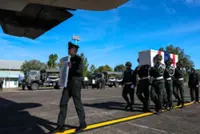IT’S a little before 8.30am and tourists are gathering in the pedestrian tunnels beneath Bangkok’s Grand Palace and Temple of the Emerald Buddha.
Decked out in sunhats, shades and elephant pants, the tourists file behind guides holding colourful flags or soft toys. One guide runs through local Thai greetings, saying in Mandarin: “You can say sawasdeeka or sawasdeekrab.”
Already a subscriber? Log in
Save 30% OFF The Star Digital Access
Cancel anytime. Ad-free. Unlimited access with perks.





